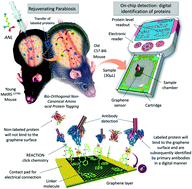Our official English website, www.x-mol.net, welcomes your feedback! (Note: you will need to create a separate account there.)
Graphene-based biosensor for on-chip detection of bio-orthogonally labeled proteins to identify the circulating biomarkers of aging during heterochronic parabiosis†
Lab on a Chip ( IF 6.1 ) Pub Date : 2018-09-17 00:00:00 , DOI: 10.1039/c8lc00446c Corinne Sadlowski 1 , Sarah Balderston , Mandeep Sandhu , Reza Hajian , Chao Liu , Thanhtra P Tran , Michael J Conboy , Jacobo Paredes , Niren Murthy , Irina M Conboy , Kiana Aran
Lab on a Chip ( IF 6.1 ) Pub Date : 2018-09-17 00:00:00 , DOI: 10.1039/c8lc00446c Corinne Sadlowski 1 , Sarah Balderston , Mandeep Sandhu , Reza Hajian , Chao Liu , Thanhtra P Tran , Michael J Conboy , Jacobo Paredes , Niren Murthy , Irina M Conboy , Kiana Aran
Affiliation

|
Studies of heterochronic parabiosis, where two animals of different ages are joined surgically, provided proof-of-principle results that systemic proteins have broad age-specific effects on tissue health and repair. In an effort to identify these systemic proteins, we previously developed a method to selectively label the proteome of only one animal joined in parabiosis utilizing bio-orthogonal non-canonical amino acid tagging (BONCAT), which can metabolically label proteins during their de novo synthesis by incorporating a methionine substitute, azido-nor-leucine (ANL), in cells expressing a mutant methionyl-tRNA synthetase (MetRSL274G). Once labeled, we can selectively identify the proteins produced by the MetRSL274G transgenic mouse in the setting of heterochronic parabiosis. This approach enabled the detection of several rejuvenating protein candidates from the young parabiont, which were transferred to the old mammalian tissue through their shared circulation. Although BONCAT is a very powerful technology, the challenges associated with its complexity including large starting material requirements and cost of ANL-labeled protein detection, such as modified antibody arrays and mass spectrometry, limit its application. Herein, we propose a lab-on-a-chip technology, termed Click-A+Chip for facile and rapid digital detection of ANL-labeled proteomes present in minute amount of sample, to replace conventional assays. Click-A+Chip is a graphene-based field effect biosensor (gFEB) which utilizes novel on-chip click-chemistry to specifically bind to ANL-labeled biomolecules. In this study, Click-A+Chip is utilized for the capture of ANL-labeled proteins transferred from young to old parabiotic mouse partners. Moreover, we were able to identify the young-derived ANL-labeled Lif-1 and leptin in parabiotic systemic milieu, confirming previous data as well as providing novel findings on the relative levels of these factors in young versus old parabionts. Summarily, our results demonstrate that Click-A+Chip can be used for rapid detection and identification of ANL-labeled proteins, significantly reducing the sample size, complexity, cost and time associated with BONCAT analysis.
中文翻译:

基于石墨烯的生物传感器,用于生物正交标记蛋白质的片上检测,以识别异时联体共生期间衰老的循环生物标志物†
对异时性联体共生的研究,即通过手术将两只不同年龄的动物结合在一起,提供了原理验证结果,表明系统蛋白对组织健康和修复具有广泛的年龄特异性影响。为了鉴定这些系统性蛋白质,我们之前开发了一种方法,利用生物正交非规范氨基酸标签(BONCAT)选择性标记参与联体共生的一只动物的蛋白质组,该方法可以在蛋白质从头合成过程中代谢标记蛋白质通过在表达突变型甲硫氨酰-tRNA合成酶(MetRS L274G)的细胞中掺入甲硫氨酸替代物叠氮正亮氨酸(ANL)。一旦标记,我们就可以选择性地识别 MetRS L274G转基因小鼠在异时联体共生环境中产生的蛋白质。这种方法能够从年轻的副生物体中检测到几种候选的恢复活力的蛋白质,这些蛋白质通过它们的共享循环转移到年老的哺乳动物组织中。尽管 BONCAT 是一项非常强大的技术,但与其复杂性相关的挑战(包括大量的起始材料要求和 ANL 标记蛋白质检测的成本(例如改良抗体阵列和质谱法))限制了其应用。在此,我们提出了一种称为 Click-A+Chip 的芯片实验室技术,用于轻松快速地数字检测微量样品中存在的 ANL 标记的蛋白质组,以取代传统的检测。Click-A+Chip 是一种基于石墨烯的场效应生物传感器 (gFEB),它利用新型片上点击化学来特异性结合 ANL 标记的生物分子。在本研究中,Click-A+Chip 用于捕获从年轻共生小鼠伙伴转移到年老共生小鼠伙伴的 ANL 标记蛋白。此外,我们能够在联生系统环境中鉴定出年轻衍生的 ANL 标记的 Lif-1 和瘦素,证实了之前的数据,并提供了关于这些因子在年轻与年老共生体中相对水平的新发现。总之,我们的结果表明 Click-A+Chip 可用于快速检测和鉴定 ANL 标记的蛋白质,显着减少与 BONCAT 分析相关的样本量、复杂性、成本和时间。
更新日期:2018-09-17
中文翻译:

基于石墨烯的生物传感器,用于生物正交标记蛋白质的片上检测,以识别异时联体共生期间衰老的循环生物标志物†
对异时性联体共生的研究,即通过手术将两只不同年龄的动物结合在一起,提供了原理验证结果,表明系统蛋白对组织健康和修复具有广泛的年龄特异性影响。为了鉴定这些系统性蛋白质,我们之前开发了一种方法,利用生物正交非规范氨基酸标签(BONCAT)选择性标记参与联体共生的一只动物的蛋白质组,该方法可以在蛋白质从头合成过程中代谢标记蛋白质通过在表达突变型甲硫氨酰-tRNA合成酶(MetRS L274G)的细胞中掺入甲硫氨酸替代物叠氮正亮氨酸(ANL)。一旦标记,我们就可以选择性地识别 MetRS L274G转基因小鼠在异时联体共生环境中产生的蛋白质。这种方法能够从年轻的副生物体中检测到几种候选的恢复活力的蛋白质,这些蛋白质通过它们的共享循环转移到年老的哺乳动物组织中。尽管 BONCAT 是一项非常强大的技术,但与其复杂性相关的挑战(包括大量的起始材料要求和 ANL 标记蛋白质检测的成本(例如改良抗体阵列和质谱法))限制了其应用。在此,我们提出了一种称为 Click-A+Chip 的芯片实验室技术,用于轻松快速地数字检测微量样品中存在的 ANL 标记的蛋白质组,以取代传统的检测。Click-A+Chip 是一种基于石墨烯的场效应生物传感器 (gFEB),它利用新型片上点击化学来特异性结合 ANL 标记的生物分子。在本研究中,Click-A+Chip 用于捕获从年轻共生小鼠伙伴转移到年老共生小鼠伙伴的 ANL 标记蛋白。此外,我们能够在联生系统环境中鉴定出年轻衍生的 ANL 标记的 Lif-1 和瘦素,证实了之前的数据,并提供了关于这些因子在年轻与年老共生体中相对水平的新发现。总之,我们的结果表明 Click-A+Chip 可用于快速检测和鉴定 ANL 标记的蛋白质,显着减少与 BONCAT 分析相关的样本量、复杂性、成本和时间。



























 京公网安备 11010802027423号
京公网安备 11010802027423号